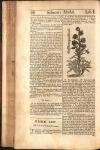

 I. The Names. Some Authors will allow this Plant no Greek Name; but others suppose it to be the same with Dioscorides his Φυτευμα: It is called in Latin, Campanula: and in English, Bell Flower.
I. The Names. Some Authors will allow this Plant no Greek Name; but others suppose it to be the same with Dioscorides his Φυτευμα: It is called in Latin, Campanula: and in English, Bell Flower.
II. The Kinds. Authors make almost an Infinite number of Kinds, amongst which are the Throat Worts, Campions, Rampions, and several other Nominals, so that they run into so great Confusion about them that it is not easy to be set right. To avoid therefore all this clutter and trouble, we shall Treat of those otherwise Denominated under their proper Titles and Names they are best known by; and in this and the succeeding Chapter, discourse only of the Chief of those which are peculiarly called Bell-Flowers.
Of the Bell-Flowers of which we shall take notice, there are two Principal Kinds, viz.
1. The Small Bell-Flower, of which we Treat in this Chapter.
2. The Great Bell-flower, of which in the next Chapter.
III. Of the Small Bell-flower, we take notice of three kinds:
1. Campanula Cerulea vel Rotundifolia, Blew or Round-leav'd Bell-flower. (Campanula rotundifolia -Henriette)
2. Campanula alba, White Bell-flower.
3. Campanula lutea, Yellow Bell-flower.
IV. The Description. The Blew or Round-leav'd has a small thready Root, from whence rises up Leaves which lye upon the ground, round and small, almost like unto a Violet-leaf but rounder, and snipped or dented, from whence rise up divers weak, slender Stalks about two foot high, set from the bottoms to the tops, with many very small, long, narrow leaves, where the flowers stand upon small long stalks, very like in fashion and bigness unto the small Garden Rampions, but of a perfect blew colour, most commonly turning towards Purple, and sometimes White, tho’ seldom: after which follows small Seeds, in small Heads, like those of Rampions.
V. The White Bell-flower ( which some account a kind of Wild Rampion ) is a small Plant with a slender Root, of the bigness of a small straw, with some strings springing from it. The leaves are somewhat long,smooth, and of a perfect green colour, lying flat upon the ground. From thence rise small tender stalks set here and there with a few leaves; and the flowers grow at the tops of them of a Milk-white colour.
VI. The Yellow Bell-flower is a very beautiful Plant of an handful high: It has roots like to the Blew or Round-leav'd ; and the leaves are almost like to the same,save that those which lie next the ground are not so round as the former, a little larger, and longish, and some of them a little dented about the edges the flowers in their way and manner of growing, are like the former, but differ only in the colour, these being of a pale yellow.
VII. The Places. They grow wild in most places in England, especially upon barren sandy Heaths, and such other like places.
VIII. The Times. They flower all the Summer long, some continuing till the cold of Autumn makes them decay.
IX. The Qualities. They are cold and dry in the first degree, of the nature of Rampions: Astringent, Stomatick, and Alterative.
X. Preparations. You may make therefrom,
1. A distilled Water of the whole Plant.
2. A Cataplasm of the Root.
The Virtues.
XI. The Distilled Water. It is good against discolourings and deformities of the skin, cleansing it, and making the face very clear and fair.
XII. The Cataplasm. The roots beaten Into a Mass, and made into a Cataplasm, with Meal of Lupins and Vinegar, is restrictive, abates the Milk in Womens Breasts, takes away spots and marks of the skin, and removes many other of its deformities.
Botanologia, or The English Herbal, was written by William Salmon, M.D., in 1710.
This chapter was proofread by Therese Richardson.

